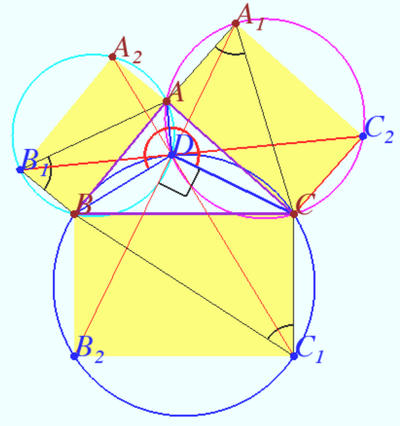Difference between revisions of "2021 USAMO Problems/Problem 1"
(→Solution: SEVERE LaTeX formatting fixing) |
|||
| (2 intermediate revisions by one other user not shown) | |||
| Line 2: | Line 2: | ||
==Solution== | ==Solution== | ||
| + | [[File:2021 USAMO 1.png|400px|right]] | ||
| + | Let <math>D</math> be the second point of intersection of the circles <math>AB_1B</math> and <math>AA_1C.</math> Then: | ||
| + | <cmath>\begin{align*} | ||
| + | \angle ADB &= 180^\circ – \angle AB_1B,&\angle ADC &= 180^\circ – \angle AA_1C\ | ||
| + | \angle BDC &= 360^\circ – \angle ADB – \angle ADC\ | ||
| + | &= 360^\circ – (180^\circ – \angle AB_1B) – (180^\circ – \angle AA_1C)\ | ||
| + | &= \angle AB_1B + \angle AA_1C\ | ||
| + | \angle BDC + \angle BC_1C &= 180^\circ | ||
| + | \end{align*}</cmath> | ||
| + | Therefore, <math>BDCC_1B_2</math> is cyclic with diameters <math>BC_1</math> and <math>CB_2</math>, and thus <math>\angle CDB_2 = 90^\circ.</math> | ||
| + | Similarly, <math>\angle CDA_1 = 90^\circ</math>, meaning points <math>A_1</math>, <math>D</math>, and <math>B_2</math> are collinear. | ||
| − | + | Similarly, the points <math>A_2, D, C_1</math> and <math>C_2, D, B_1</math> are collinear. | |
| − | + | ||
| − | + | (After USAMO 2021 Solution Notes – Evan Chen) | |
| − | + | ||
| − | + | '''vladimir.shelomovskii@gmail.com, vvsss''' | |
| + | |||
| + | {{MAA Notice}} | ||
Latest revision as of 12:32, 25 December 2023
Rectangles ![]()
![]() and
and ![]() are erected outside an acute triangle
are erected outside an acute triangle ![]() Suppose that
Suppose that![]() Prove that lines
Prove that lines ![]()
![]() and
and ![]() are concurrent.
are concurrent.
Solution
Let ![]() be the second point of intersection of the circles
be the second point of intersection of the circles ![]() and
and ![]() Then:
Then:
 Therefore,
Therefore, ![]() is cyclic with diameters
is cyclic with diameters ![]() and
and ![]() , and thus
, and thus ![]() Similarly,
Similarly, ![]() , meaning points
, meaning points ![]() ,
, ![]() , and
, and ![]() are collinear.
are collinear.
Similarly, the points ![]() and
and ![]() are collinear.
are collinear.
(After USAMO 2021 Solution Notes – Evan Chen)
vladimir.shelomovskii@gmail.com, vvsss
The problems on this page are copyrighted by the Mathematical Association of America's American Mathematics Competitions. 










